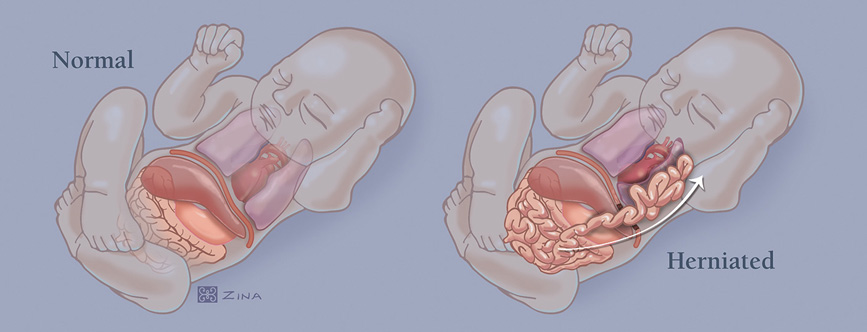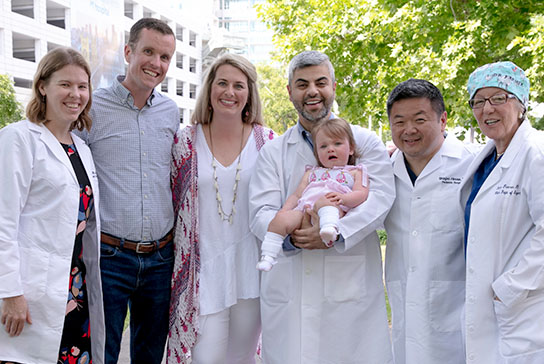Fetal Care and Treatment Center
Congenital diaphragmatic hernia

What is congenital diaphragmatic hernia?
The wide, flat muscle that separates the chest and abdominal cavities is the diaphragm, which forms at eight weeks’ gestation. When it does not form completely, a hole is created. This defect is called a congenital diaphragmatic hernia (CDH).
The hole allows the contents of the abdomen (stomach, intestine, liver, spleen and kidneys) to go up into the developing baby’s chest, preventing the lungs from growing to normal size. While in the uterus, a fetus does not need its lungs to breathe because the placenta performs this function. Newborns with CDH, however, might not be able to breathe well enough to survive if the lungs are too small. These babies may also have problems with high blood pressure in the lungs called pulmonary hypertension.
There are two kinds of congenital diaphragmatic hernia:
- A Bochdalek hernia is a hole in the back of the diaphragm; 90 percent of congenital diaphragmatic hernias are this type
- A Morgagni hernia involves a hole in front of the diaphragm
About 85 percent of CDHs are on the left side. CDHs on the right side can be associated with a poorer prognosis.
Diagnosis
Many CDHs are detected during routine prenatal screening. Various measurements and follow-up tests can determine:
- If the defect is CDH or another similar-appearing condition
- If the CDH is associated with an additional problem or cluster of problems
- The severity of the defect
Treatment
Infants born with CDH must be treated in a neonatal intensive care unit (NICU) by an experienced care team, as CDH patients almost always require airway tubes and mechanical ventilation to help with breathing.
Surgery to repair CDH is often done a few days after birth. The timing depends on how the baby is doing overall along with the severity of pulmonary hypertension or other problems. The diaphragm repair can generally be done in one of two ways. The first involves an incision on the abdomen through which intestines and other organs can be moved from the chest to the abdomen. The diaphragm is closed with stitches or a patch.
Another method is called thoracoscopic or minimally invasive repair. This procedure involves inserting instruments through three or four tiny incisions in the baby's chest and then moving the abdominal organs into the abdomen. The diaphragm can be closed using the same three or four tiny openings. Sometimes, a patch is required to close the hole.
Outcomes
Babies with CDH do not require special prenatal management in terms of the timing or type of delivery, but they should be delivered in a specialized perinatal center. In general, they tend to well with surgery and care in a NICU. Some may require intensive care for several weeks after birth.
Babies with a severe form of the disorder will be born with very small lungs or severe pulmonary hypertension. Some will not survive. Those who do may later have learning differences, breathing conditions, hearing loss or growth problems.
Of those babies with CDH, somewhere between least severe and severe, some will live normal lives while others will have some handicaps, depending on how well the lungs were able to grow before birth.
Contact us or make a referral
Physicians, patients and families can contact the Fetal Care and Treatment Center to find out more about our fetal care services.
Wondering about what types of conditions should be referred to us? View list of conditions to refer.
Referring physicians from other facilities, please use our Fetal Care and Treatment Center Referral form to refer patients and request services.
UC Davis Children’s Hospital
4301 X Street, 1st Floor, Suite 1501
Sacramento, CA 95817
The Fetal Care and Treatment Center is located within UC Davis Children’s Hospital.
View map and directionsarrow_forward

